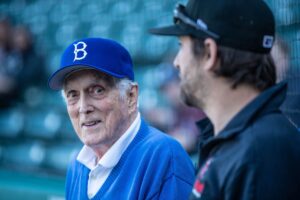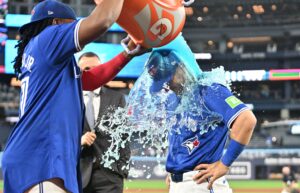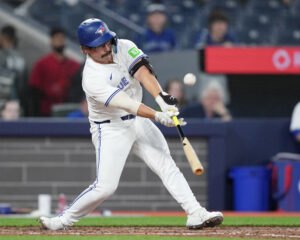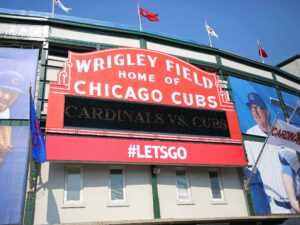In 2015 and 2016, the New York Mets were a magical team. From a team that won the NL East for the first time since 2006 and went to the World Series, to a team that battled through injuries and the loss of stars like Daniel Murphy to make it to the NL Wild Card, they seemed like they were destined for long-term success. From their offensive core of Yoenis Céspedes, the up-and-coming Michael Conforto, Lucas Duda, and Jay Bruce, among others, to their dominant pitching, headlined by Noah Syndergaard, Jacob deGrom, and Matt Harvey, the Mets seemed like they were here to stay. Only they weren’t. As of writing this, they went from NL Champions to Wild Card defeat, to a 56-71 team in 2017.
While the reasons are abundant to what happened to create the team as it is now, there are three that stick out: Injuries, underwhelming performances from role players, and trades.
What Happened to the 2017 New York Mets?
Injuries
The most obvious cause for the regression of the Mets has been their issue with injuries. Currently, there are 10 players on the DL for the Mets. The biggest issue with this list is that the players aren’t inconsequential. Four of the 2016 team’s top-12 in WAR (including their number one in WAR, Syndergaard) are currently on the DL. Recently, the Mets lone All-Star, Conforto, dislocated his shoulder swinging and is out for the season. Along with the current list of injuries, a total of 22 players (including ones traded) have missed some sort of time due to injury.
The biggest cause of these injuries has been neglect of the training staff to recognize issues with team health. This started all the way back in offseason, with the training regiments of Syndergaard and Céspedes. Syndergaard vowed to get stronger and throw faster, digging into his now famed Bowls of Doom and gaining more muscle. On the other side, Céspedes was doing intensive weight lifting, including a 900-pound bear squat. The issue with these is that baseball is not a sport where bulking up should be the primary concern. Building muscle is not conducive to the way baseball is played and played a big part in the injuries of Syndergaard and Céspedes. During the season, Syndergaard famously declined an MRI and chose to start in a game shortly thereafter. The start ended with him suffering a torn lat, ending his season.
The most recent case of neglect happened with Steven Matz. Matz pitched through pain all season and only recently decided to undergo surgery to help with nerve damage in his pitching elbow. He at times turned to multiple pain killing injections to help him get from start to start. But nonetheless, he struggled and finished the season with a career-high 6.08 ERA.
It is nearly impossible to succeed whilst constantly taking blows like this, unless you can get contributions from nearly everyone who steps up in players absences, much like the Mets of last year. This year, however, is not the case.
Underwhelming Performances
Three of the biggest reasons for the late-season playoff run last year were three players: Seth Lugo, Robert Gsellman, and TJ Rivera. They were all players that stepped up when injuries hampered the potential success of the team.
Lugo and Gsellman posted 2.67 and 2.42 ERA’s, respectively and Rivera hit .333 in 105 at-bats, including a clutch late season home run in a win against the division-leading Washington Nationals. These players stepped in when they were needed the most and didn’t let the stage get the best of them. Instead they helped their team to success.
Gsellman and Lugo even cracked the Mets top-12 in WAR in their 15 collective starts. However, this year has been completely different. All three have seen time on the DL, the earliest of which being Lugo, who suffered a slight UCL tear after his time in the World Baseball Classic. While Rivera is still hitting well, Gsellman and Lugo have seen a sharp decline, carrying 5.65 and 4.85 ERA’s with them.
Every replacement starter the Mets have had, from Rafael Montero to Adam Wilk, has posted an ERA above 5. This has led to the Mets, a team whose rotation was once hailed as one of the best in baseball, having one of the worst collective starting pitching ERA this season. This lack of successful pitching, in the rotation and in the bullpen, has been another of the largest causes of the Mets regression.
Trades
It’s commonplace to see a team towards the bottom of the standings become sellers at the trade deadlines. It’s encouraged, even. Build up a base of prospects for the future using players that contenders need now.
What’s underwhelming, and perhaps most concerning, is the return the Mets got for these players. The trades in question here are the Bruce trade and the Neil Walker trade. While the prospects received in return for Duda, Addison Reed, and Curtis Granderson may seem underwhelming to some from a cursory glance, they make sense. No team was going to break the bank for players on expiring deals, and no team really did. However, the Mets were able to net three top-30 prospects from the Boston Red Sox, and players who are now in Double-A and Triple-A from the Tampa Bay Rays and Los Angeles Dodgers, respectively.
The questionable trades the Mets made were the Walker and Bruce trades. Both of them were possibly re-signable players that would’ve played immensely important parts for a potentially successful 2018 Mets team. Their deal for closer A.J. Ramos insinuates that they intend to be competitive next year, yet they were traded away for disappointing returns.
While the jury is still out on the Walker trade, a Player To Be Named Later isn’t always a good sign. The return in the Bruce deal was Ryder Ryan, a 30th-round pick from the Cleveland Indians. The Mets traded away Bruce, who was having one of the best years on the Mets this year, for a player who has posted a 5.29 ERA in two years of Rookie and Single-A baseball. If Bruce re-signs with the Indians and Ryan turns into nothing, it could become one of the more lopsided trades in recent memory. The Mets didn’t swing and miss on every trade they’ve made thus far, but the ones they have could prove costly.
Positives
Now, despite this disappointing year for the Mets, it’s not all gray. This year saw the breakout of Conforto and the beginning of the Amed Rosario and Dominic Smith era. While Conforto is out for the rest of the season, he has a whole offseason to recover, and Rosario and Smith, two top prospects, have shown impressive flashes of what their future potential can hold. Along with these young bright spots, they’ll hopefully be getting a 100% healthy Cy Young candidate back in Syndergaard and a healthy Matz. The acquisition of Ramos bolsters the back end of a bullpen that will feature Jeurys Familia, Jerry Blevins, and a handful of question marks.
As far as free agency goes, the Mets have been tied to names like Mike Moustakas and Lorenzo Cain, which would fix some of the biggest issues the Mets have: the lack of a definite third baseman and all-around center fielder. Along with these two names, they must try to find a little more to bolster up their bullpen and potentially a starter, if Gsellman and Lugo don’t return to form.
While it’s typical for Mets fans to get excited for the upcoming year, 2018 has the potential to justify the excitement, despite what has overall been a disappointing, to say the least, 2017 season.
Embed from Getty Images






